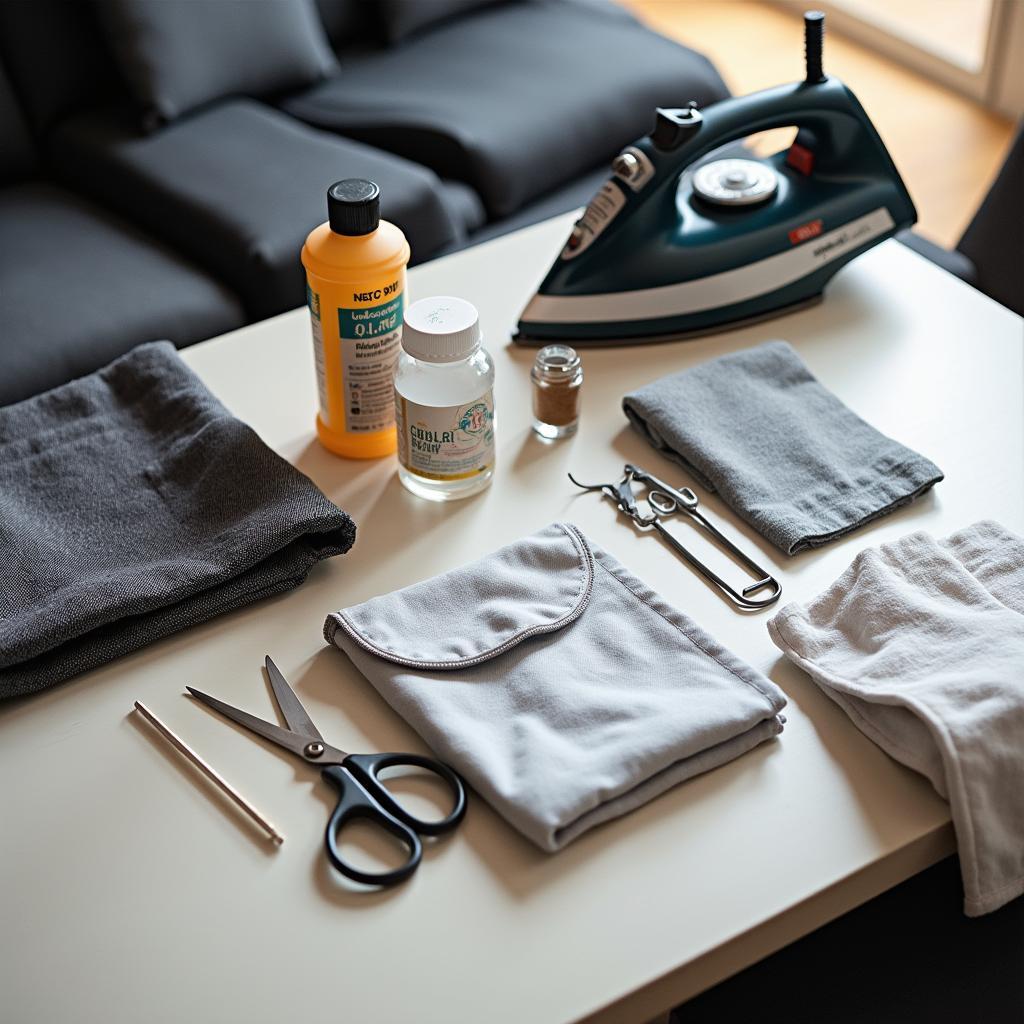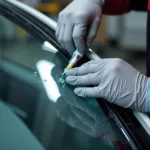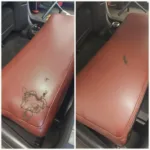Discovering a tear in your cloth car seat can be disheartening, but fret not! With the right tools and techniques, you can restore your car’s interior to its former glory. This guide will walk you through the process of repairing a cloth car seat tear, covering everything from simple fixes to more involved repairs.
Assess the Damage: Is It a Simple Fix or a Major Repair?
Before diving into the repair, it’s essential to evaluate the extent of the damage. A minor snag or small cut might require a quick fix, while a large tear or extensive fraying might necessitate more involved methods.
Gather Your Repair Arsenal: Tools and Materials You’ll Need
Having the right tools and materials on hand can make the repair process smoother. Here’s a list of items you might need:
- Fabric Repair Kit: These handy kits typically include fabric patches, adhesive, and a color matching guide.
- Needle and Thread: Opt for a thread color that closely matches your car seat fabric.
- Scissors: A sharp pair of scissors is crucial for precise cutting.
- Iron and Ironing Board: Some repair methods require heat setting.
- Upholstery Cleaner: Cleaning the area around the tear ensures better adhesion and a cleaner finish.
- Heavy Object (optional): A book or weight can be helpful for holding the repaired area in place while the adhesive dries.
Simple Fixes for Minor Tears and Snags
- Fabric Glue or Adhesive: This is your go-to solution for small tears and snags. Apply a small amount of fabric glue to the underside of the torn fabric and carefully press the edges together.
- Sewing: For slightly larger tears or those in a less visible area, threading a needle and carefully stitching the tear closed can be an effective solution.
Advanced Repair Techniques for Larger Tears
- Iron-on Patches: Fabric repair kits often contain iron-on patches. These patches have a heat-activated adhesive. Follow the kit’s instructions to iron the patch onto the backside of the torn fabric, effectively covering the damage.
- Sew-on Patches: For a sturdier repair, consider using a sew-on patch. Cut a patch slightly larger than the tear, position it on the backside of the fabric, and hand-stitch or machine-sew it around the edges.
Tips for a Seamless Repair
- Clean the Area: Before starting any repair, thoroughly clean the area around the tear using upholstery cleaner and a soft brush to remove dirt, dust, and debris.
- Test on a Hidden Area: If using fabric glue or an iron-on patch, test it on a hidden area of the car seat first to ensure colorfastness and adhesion.
- Work in a Well-Ventilated Area: Some fabric glues and adhesives emit fumes, so ensure proper ventilation.
- Be Patient: Allow ample drying time for adhesives and avoid using the car seat until the repair is fully cured.
When to Consider Professional Upholstery Repair
While DIY repairs can be successful for many cloth car seat tears, some situations might require the expertise of a professional upholstery shop. These include:
- Extensive Damage: Tears that are very large, complex, or involve multiple layers of fabric.
- Airbag Deployment: If the tear occurred due to airbag deployment, it’s best to consult a professional to ensure the seat’s structural integrity hasn’t been compromised.
- Luxury or Classic Cars: For high-value vehicles, seeking professional upholstery repair can help maintain the car’s value.
Frequently Asked Questions about Cloth Car Seat Repair
Q: Can I use super glue to repair a car seat tear?
A: It’s not recommended to use super glue as it can dry stiff and potentially damage the fabric further. Opt for fabric glue or adhesive specifically designed for upholstery repairs.
Q: How long does it take for fabric glue to dry on a car seat?
A: Drying times vary depending on the type of fabric glue used. Always refer to the manufacturer’s instructions, but most fabric glues dry to the touch within a few hours and cure completely within 24 hours.
Q: Can I wash my car seats after repairing a tear?
A: It’s best to avoid machine washing car seats, especially after a repair. Spot cleaning with upholstery cleaner is generally sufficient to maintain cleanliness.
Q: How much does it cost to get a car seat professionally repaired?
A: The cost of professional car seat repair can vary widely based on factors like the extent of the damage, the type of fabric, and the location of the repair shop. How much does it cost to repair a car seat? Provides a detailed breakdown of car seat repair costs.
Q: Can I prevent future car seat tears?
A: While it’s impossible to completely prevent wear and tear, using seat covers, being mindful of sharp objects, and addressing spills promptly can help prolong the life of your car seats.
Conclusion
Repairing a cloth car seat tear doesn’t have to be a daunting task. By following this guide and choosing the appropriate repair method, you can restore your car’s interior and ensure a comfortable ride for miles to come. If you encounter a repair that seems beyond your skill level, don’t hesitate to seek professional help.
Remember, taking care of those minor rips and tears can go a long way in maintaining the overall condition and value of your vehicle. For those seeking guidance on leather car seat repair in the Bolton area, you can find valuable information at car leather seat repair bolton. And if you’re facing the challenge of repairing a car seat bolster, our guide on how to shape foam to repair car seat bolster can provide valuable insights.



